check engine light Mercury Montego 2006 Owner's Manuals
[x] Cancel search | Manufacturer: MERCURY, Model Year: 2006, Model line: Montego, Model: Mercury Montego 2006Pages: 272, PDF Size: 2.41 MB
Page 10 of 272
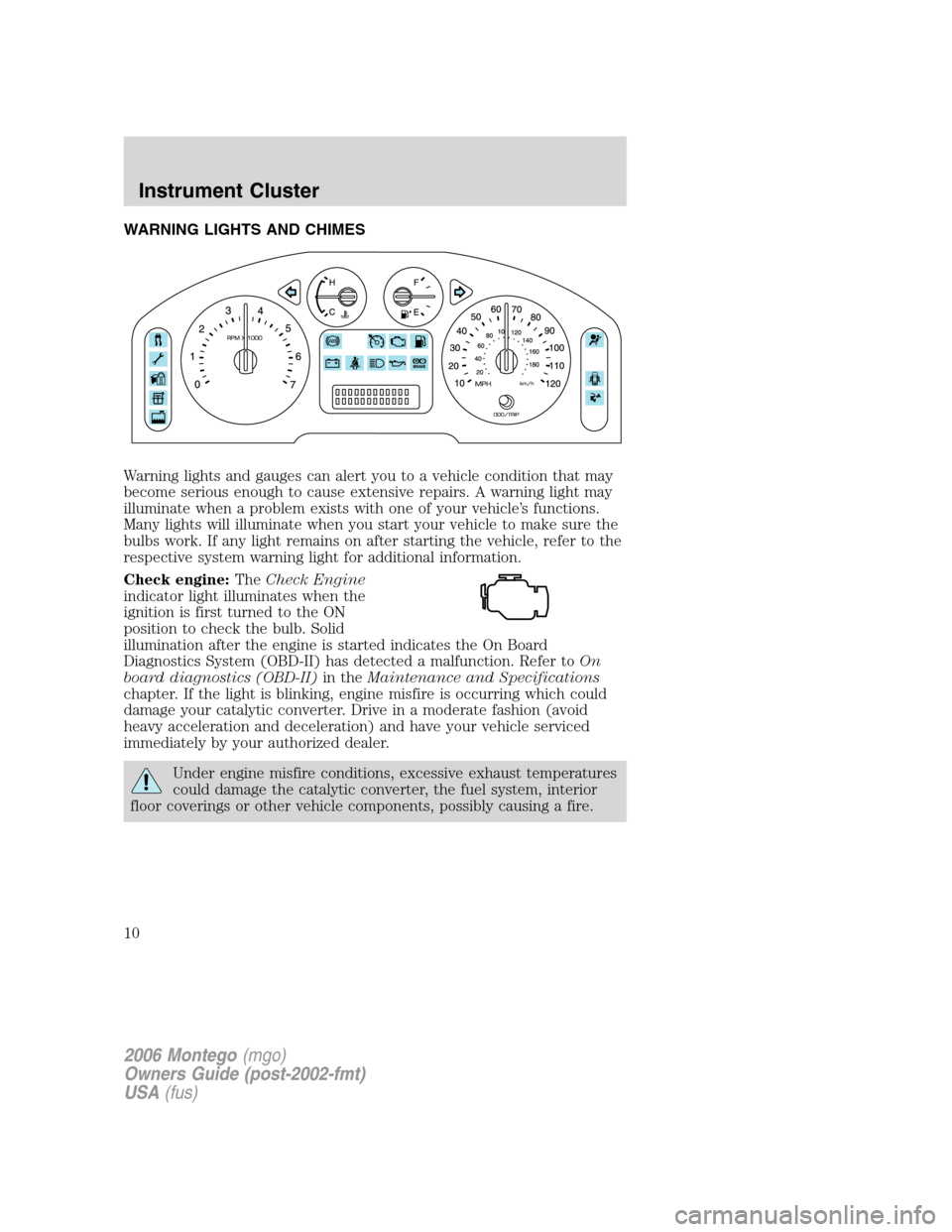
WARNING LIGHTS AND CHIMES
Warning lights and gauges can alert you to a vehicle condition that may
become serious enough to cause extensive repairs. A warning light may
illuminate when a problem exists with one of your vehicle’s functions.
Many lights will illuminate when you start your vehicle to make sure the
bulbs work. If any light remains on after starting the vehicle, refer to the
respective system warning light for additional information.
Check engine:TheCheck Engine
indicator light illuminates when the
ignition is first turned to the ON
position to check the bulb. Solid
illumination after the engine is started indicates the On Board
Diagnostics System (OBD-II) has detected a malfunction. Refer toOn
board diagnostics (OBD-II)in theMaintenance and Specifications
chapter. If the light is blinking, engine misfire is occurring which could
damage your catalytic converter. Drive in a moderate fashion (avoid
heavy acceleration and deceleration) and have your vehicle serviced
immediately by your authorized dealer.
Under engine misfire conditions, excessive exhaust temperatures
could damage the catalytic converter, the fuel system, interior
floor coverings or other vehicle components, possibly causing a fire.
2006 Montego(mgo)
Owners Guide (post-2002-fmt)
USA(fus)
Instrument Cluster
10
Page 11 of 272
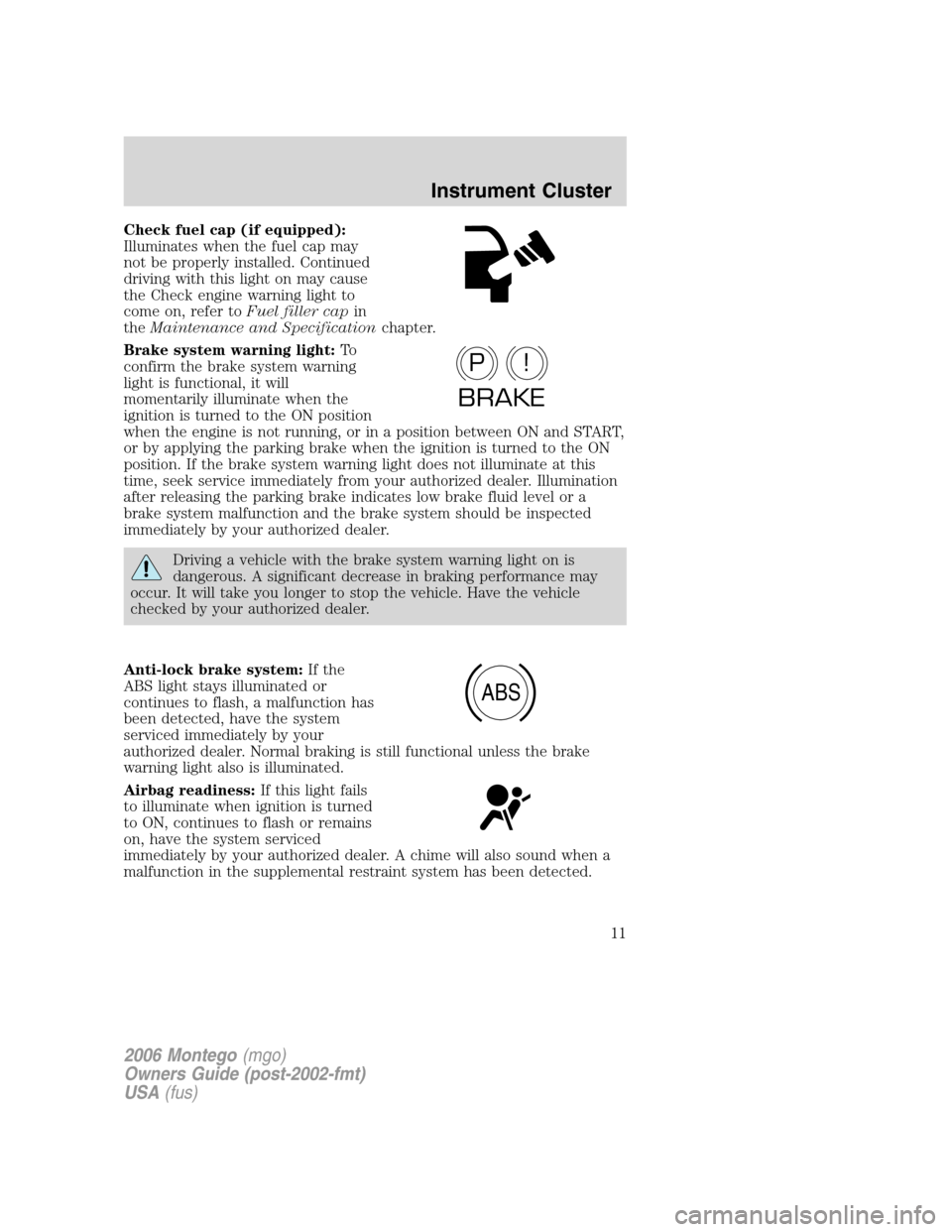
Check fuel cap (if equipped):
Illuminates when the fuel cap may
not be properly installed. Continued
driving with this light on may cause
the Check engine warning light to
come on, refer toFuel filler capin
theMaintenance and Specificationchapter.
Brake system warning light:To
confirm the brake system warning
light is functional, it will
momentarily illuminate when the
ignition is turned to the ON position
when the engine is not running, or in a position between ON and START,
or by applying the parking brake when the ignition is turned to the ON
position. If the brake system warning light does not illuminate at this
time, seek service immediately from your authorized dealer. Illumination
after releasing the parking brake indicates low brake fluid level or a
brake system malfunction and the brake system should be inspected
immediately by your authorized dealer.
Driving a vehicle with the brake system warning light on is
dangerous. A significant decrease in braking performance may
occur. It will take you longer to stop the vehicle. Have the vehicle
checked by your authorized dealer.
Anti-lock brake system:If the
ABS light stays illuminated or
continues to flash, a malfunction has
been detected, have the system
serviced immediately by your
authorized dealer. Normal braking is still functional unless the brake
warning light also is illuminated.
Airbag readiness:If this light fails
to illuminate when ignition is turned
to ON, continues to flash or remains
on, have the system serviced
immediately by your authorized dealer. A chime will also sound when a
malfunction in the supplemental restraint system has been detected.
P!
BRAKE
ABS
2006 Montego(mgo)
Owners Guide (post-2002-fmt)
USA(fus)
Instrument Cluster
11
Page 166 of 272
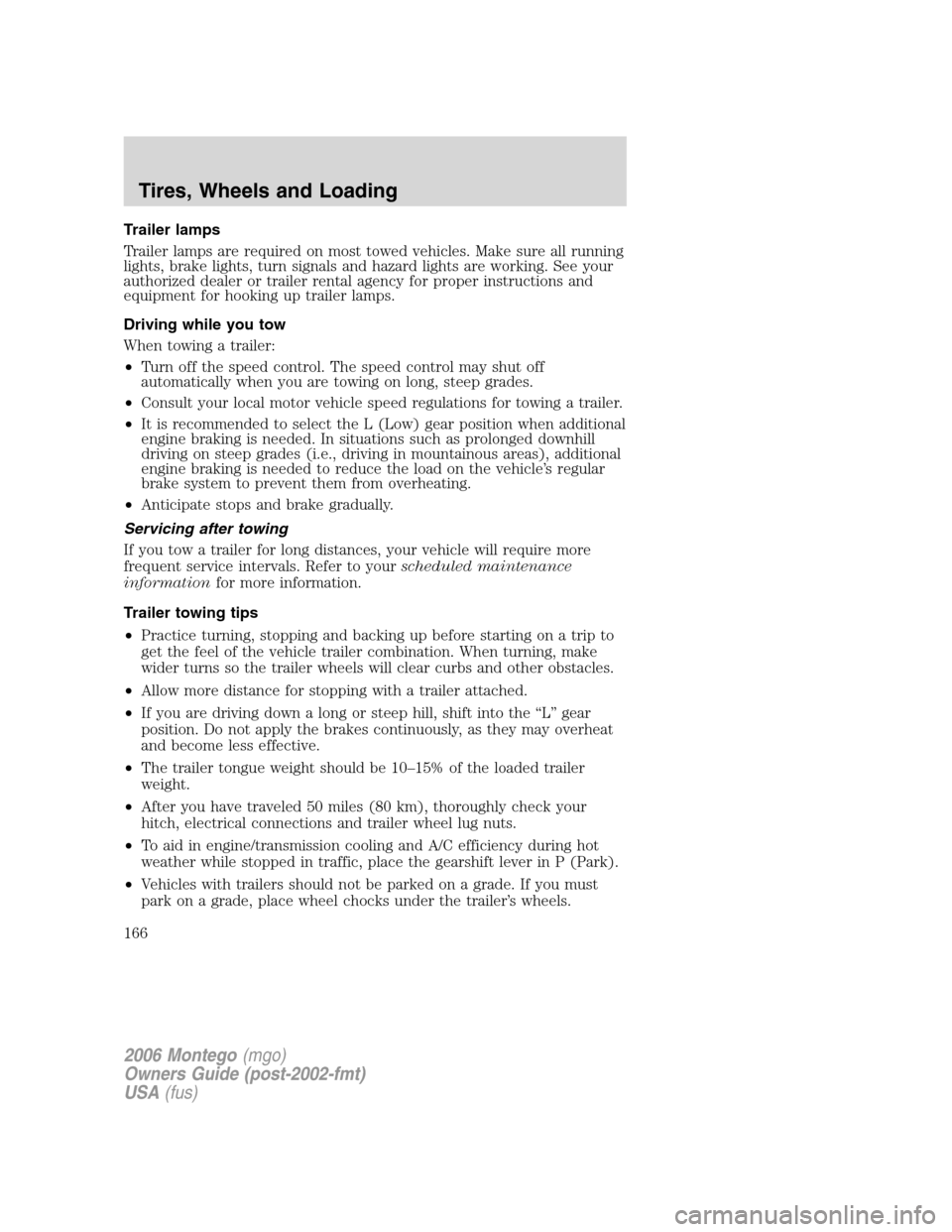
Trailer lamps
Trailer lamps are required on most towed vehicles. Make sure all running
lights, brake lights, turn signals and hazard lights are working. See your
authorized dealer or trailer rental agency for proper instructions and
equipment for hooking up trailer lamps.
Driving while you tow
When towing a trailer:
•Turn off the speed control. The speed control may shut off
automatically when you are towing on long, steep grades.
•Consult your local motor vehicle speed regulations for towing a trailer.
•It is recommended to select the L (Low) gear position when additional
engine braking is needed. In situations such as prolonged downhill
driving on steep grades (i.e., driving in mountainous areas), additional
engine braking is needed to reduce the load on the vehicle’s regular
brake system to prevent them from overheating.
•Anticipate stops and brake gradually.
Servicing after towing
If you tow a trailer for long distances, your vehicle will require more
frequent service intervals. Refer to yourscheduled maintenance
informationfor more information.
Trailer towing tips
•Practice turning, stopping and backing up before starting on a trip to
get the feel of the vehicle trailer combination. When turning, make
wider turns so the trailer wheels will clear curbs and other obstacles.
•Allow more distance for stopping with a trailer attached.
•If you are driving down a long or steep hill, shift into the “L” gear
position. Do not apply the brakes continuously, as they may overheat
and become less effective.
•The trailer tongue weight should be 10–15% of the loaded trailer
weight.
•After you have traveled 50 miles (80 km), thoroughly check your
hitch, electrical connections and trailer wheel lug nuts.
•To aid in engine/transmission cooling and A/C efficiency during hot
weather while stopped in traffic, place the gearshift lever in P (Park).
•Vehicles with trailers should not be parked on a grade. If you must
park on a grade, place wheel chocks under the trailer’s wheels.
2006 Montego(mgo)
Owners Guide (post-2002-fmt)
USA(fus)
Tires, Wheels and Loading
166
Page 184 of 272

If your vehicle is equipped with a 6–speed transmission:When
driving at slow speeds in deep sand under high outside temperatures,
use L (Low) gear when possible. L (Low) gear operation will maximize
the engine and transmission cooling capability.Do not perform this
operation if your vehicle is equipped with an
electronically-controlled CVT.
Under severe operating conditions, the A/C may cycle on and off to
protect overheating of the engine.
Avoid excessive speed because vehicle momentum can work against you
and cause the vehicle to become stuck to the point that assistance may
be required from another vehicle. Remember, you may be able to back
out the way you came if you proceed with caution.
Mud and water
If you must drive through high water, drive slowly. Traction or brake
capability may be limited.
When driving through water, determine the depth; avoid water higher
than the bottom of the hubs (if possible) and proceed slowly. If the
ignition system gets wet, the vehicle may stall.
Once through water, always try the brakes. Wet brakes do not stop the
vehicle as effectively as dry brakes. Drying can be improved by moving
your vehicle slowly while applying light pressure on the brake pedal.
Be cautious of sudden changes in vehicle speed or direction when you
are driving in mud. Even AWD vehicles can lose traction in slick mud. As
when you are driving over sand, apply the accelerator slowly and avoid
spinning your wheels. If the vehicle does slide, steer in the direction of
the slide until you regain control of the vehicle.
If the transmission, AWD system components or axles are submerged in
water, their fluids should be checked and changed, if necessary.
Driving through deep water may damage the transmission.
If the front or rear axle is submerged in water, the axle lubricant and
PTU (Power Transfer Unit) lubricant should be checked and changed if
necessary.
After driving through mud, clean off residue stuck to rotating driveshafts
and tires. Excess mud stuck on tires and rotating driveshafts causes an
imbalance that could damage drive components.
2006 Montego(mgo)
Owners Guide (post-2002-fmt)
USA(fus)
Driving
184
Page 204 of 272

Do not attempt to push-start your vehicle. Automatic
transmissions do not have push-start capability; doing so may
damage the catalytic converter.
Preparing your vehicle
When the battery is disconnected or a new battery is installed, the
transmission must relearn its shift strategy. As a result, the transmission
may have firm and/or soft shifts. This operation is considered normal and
will not affect function or durability of the transmission. Over time, the
adaptive learning process will fully update transmission operation.
1.Use only a 12–volt supply to start your vehicle.
2. Do not disconnect the battery of the disabled vehicle as this could
damage the vehicle’s electrical system.
3. Park the booster vehicle close to the hood of the disabled vehicle
making sure the two vehiclesdo nottouch. Set the parking brake on
both vehicles and stay clear of the engine cooling fan and other moving
parts.
4. Check all battery terminals and remove any excessive corrosion before
you attach the battery cables. Ensure that vent caps are tight and level.
5. Turn the heater fan on in both vehicles to protect any electrical
surges. Turn all other accessories off.
Connecting the jumper cables
1. Connect the positive (+) jumper cable to the positive (+) terminal of
the discharged battery.
Note:In the illustrations,lightning boltsare used to designate the
assisting (boosting) battery.
+–+–
2006 Montego(mgo)
Owners Guide (post-2002-fmt)
USA(fus)
Roadside Emergencies
204
Page 225 of 272
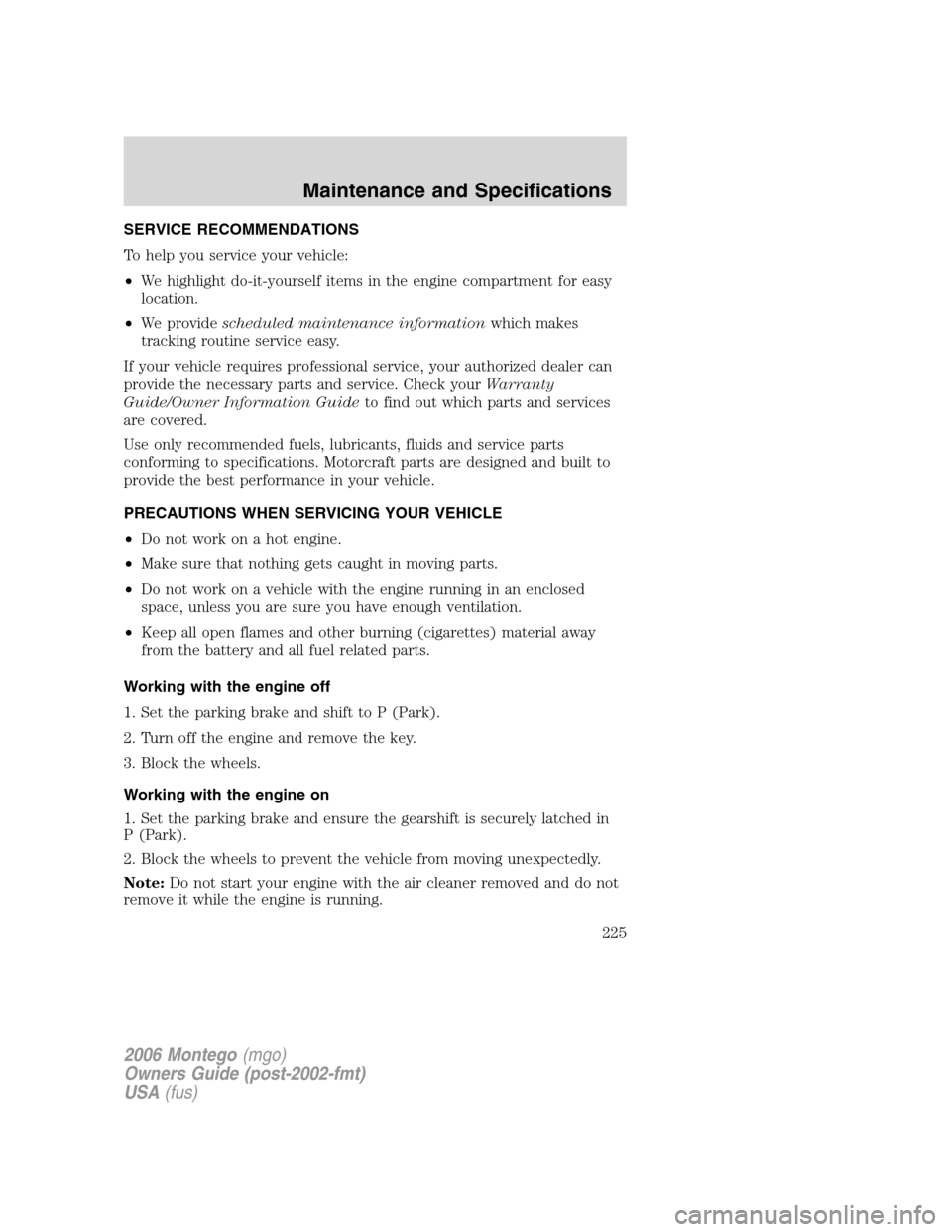
SERVICE RECOMMENDATIONS
To help you service your vehicle:
•We highlight do-it-yourself items in the engine compartment for easy
location.
•We providescheduled maintenance informationwhich makes
tracking routine service easy.
If your vehicle requires professional service, your authorized dealer can
provide the necessary parts and service. Check yourWarranty
Guide/Owner Information Guideto find out which parts and services
are covered.
Use only recommended fuels, lubricants, fluids and service parts
conforming to specifications. Motorcraft parts are designed and built to
provide the best performance in your vehicle.
PRECAUTIONS WHEN SERVICING YOUR VEHICLE
•Do not work on a hot engine.
•Make sure that nothing gets caught in moving parts.
•Do not work on a vehicle with the engine running in an enclosed
space, unless you are sure you have enough ventilation.
•Keep all open flames and other burning (cigarettes) material away
from the battery and all fuel related parts.
Working with the engine off
1. Set the parking brake and shift to P (Park).
2. Turn off the engine and remove the key.
3. Block the wheels.
Working with the engine on
1. Set the parking brake and ensure the gearshift is securely latched in
P (Park).
2. Block the wheels to prevent the vehicle from moving unexpectedly.
Note:Do not start your engine with the air cleaner removed and do not
remove it while the engine is running.
2006 Montego(mgo)
Owners Guide (post-2002-fmt)
USA(fus)
Maintenance and Specifications
225
Page 244 of 272

Do not be concerned if your engine sometimes knocks lightly. However, if
it knocks heavily under most driving conditions while you are using fuel
with the recommended octane rating, see your authorized dealer to
prevent any engine damage.
Fuel quality
If you are experiencing starting, rough idle or hesitation driveability
problems, try a different brand of unleaded gasoline. “Premium”
unleaded gasoline is not recommended for vehicles designed to use
“Regular” unleaded gasoline because it may cause these problems to
become more pronounced. If the problems persist, see your authorized
dealer.
It should not be necessary to add any aftermarket products to your fuel
tank if you continue to use high quality fuel of the recommended octane
rating. Aftermarket products could cause damage to the fuel system.
Repairs to correct the effects of using an aftermarket product in your
fuel may not be covered by your warranty.
Many of the world’s automakers approved the World-wide Fuel Charter
that recommends gasoline specifications to provide improved
performance and emission control system protection for your vehicle.
Gasolines that meet the World-wide Fuel Charter should be used when
available. Ask your fuel supplier about gasolines that meet the
World-wide Fuel Charter.
Cleaner air
Ford endorses the use of reformulated “cleaner-burning” gasolines to
improve air quality.
Running out of fuel
Avoid running out of fuel because this situation may have an adverse
effect on powertrain components.
If you have run out of fuel:
•You may need to cycle the ignition from off to on several times after
refueling, to allow the fuel system to pump the fuel from the tank to
the engine.
•The
indicator may come on. For more information on the “check
engine” or the “service engine soon” indicator, refer toWarning lights
and chimesin theInstrument Clusterchapter.
2006 Montego(mgo)
Owners Guide (post-2002-fmt)
USA(fus)
Maintenance and Specifications
244
Page 247 of 272

•You may want to turn off the speed control in hilly terrain if
unnecessary shifting between third and fourth gear occurs.
Unnecessary shifting of this type could result in reduced fuel
economy.
•Warming up a vehicle on cold mornings is not required and may
reduce fuel economy.
•Resting your foot on the brake pedal while driving may reduce fuel
economy.
•Combine errands and minimize stop-and-go driving.
Maintenance
•Keep tires properly inflated and use only recommended size.
•Operating a vehicle with the wheels out of alignment will reduce fuel
economy.
•Use recommended engine oil. Refer toLubricant specificationsin
this chapter.
•Perform all regularly scheduled maintenance items. Follow the
recommended maintenance schedule and owner maintenance checks
found inscheduled maintenance information.
Conditions
•Heavily loading a vehicle or towing a trailer may reduce fuel economy
at any speed.
•Carrying unnecessary weight may reduce fuel economy (approximately
1 mpg [0.4 km/L] is lost for every 400 lb [180 kg] of weight carried).
•Adding certain accessories to your vehicle (for example bug
deflectors, rollbars/light bars, running boards, ski/luggage racks) may
reduce fuel economy.
•Using fuel blended with alcohol may lower fuel economy.
•Fuel economy may decrease with lower temperatures during the first
8–10 miles (12–16 km) of driving.
•Driving on flat terrain offers improved fuel economy as compared to
driving on hilly terrain.
•Transmissions give their best fuel economy when operated in the top
cruise gear and with steady pressure on the gas pedal.
•Close windows for high speed driving.
EPA window sticker
Every new vehicle should have the EPA window sticker. Contact your
authorized dealer if the window sticker is not supplied with your vehicle.
2006 Montego(mgo)
Owners Guide (post-2002-fmt)
USA(fus)
Maintenance and Specifications
247
Page 265 of 272

A
Accessory delay ..........................59
Air cleaner filter .......................254
Air conditioning ....................39, 41
Airbag supplemental restraint
system ........................118, 127, 129
and child safety seats ............120
description ..............118, 127, 129
disposal ....................................132
driver airbag ............120, 127, 130
indicator light .................126, 132
operation .................120, 127, 130
passenger airbag .....120, 127, 130
side airbag ...............................127
All Wheel Drive (AWD),
driving off road .........................181
Antifreeze
(see Engine coolant) ................234
Anti-lock brake system
(see Brakes) ......................171–172
Anti-theft system ..................92, 95
arming the system ....................95
disarming a triggered
system .......................................96
triggering ...................................96
Audio system (see Radio) ...16, 19
Automatic transaxle
fluid, adding ....................251–252
fluid, checking ................251–252
fluid, refill capacities ..............255
fluid, specification ..................259
Automatic transmission
driving an automatic
overdrive .........................176, 178
Axle
lubricant specifications ..........257
B
Battery .......................................232acid, treating emergencies .....232
jumping a disabled battery ....203
maintenance-free ....................232
replacement, specifications ...254
servicing ..................................232
BeltMinder .................................113
Brakes ........................................171
anti-lock ...........................171–172
anti-lock brake system
(ABS) warning light ...............172
fluid, checking and adding ....251
fluid, refill capacities ..............255
fluid, specifications .........257, 259
lubricant specifications ..257, 259
parking ....................................172
shift interlock ..........................175
Bulbs ............................................49
C
Capacities for refilling fluids ....255
Cargo net .....................................79
Cassette tape player ...................16
Cell phone use ..............................7
Changing a tire .........................197
Child safety restraints ..............133
child safety belts ....................133
Child safety seats ......................136
attaching with tether straps ..140
in front seat ............................137
in rear seat ..............................137
Cleaning your vehicle
engine compartment ..............220
instrument panel ....................221
interior .....................................222
interior trim ............................222
plastic parts ............................220
washing ....................................218
waxing .....................................219
2006 Montego(mgo)
Owners Guide (post-2002-fmt)
USA(fus)
Index
265
Page 268 of 272
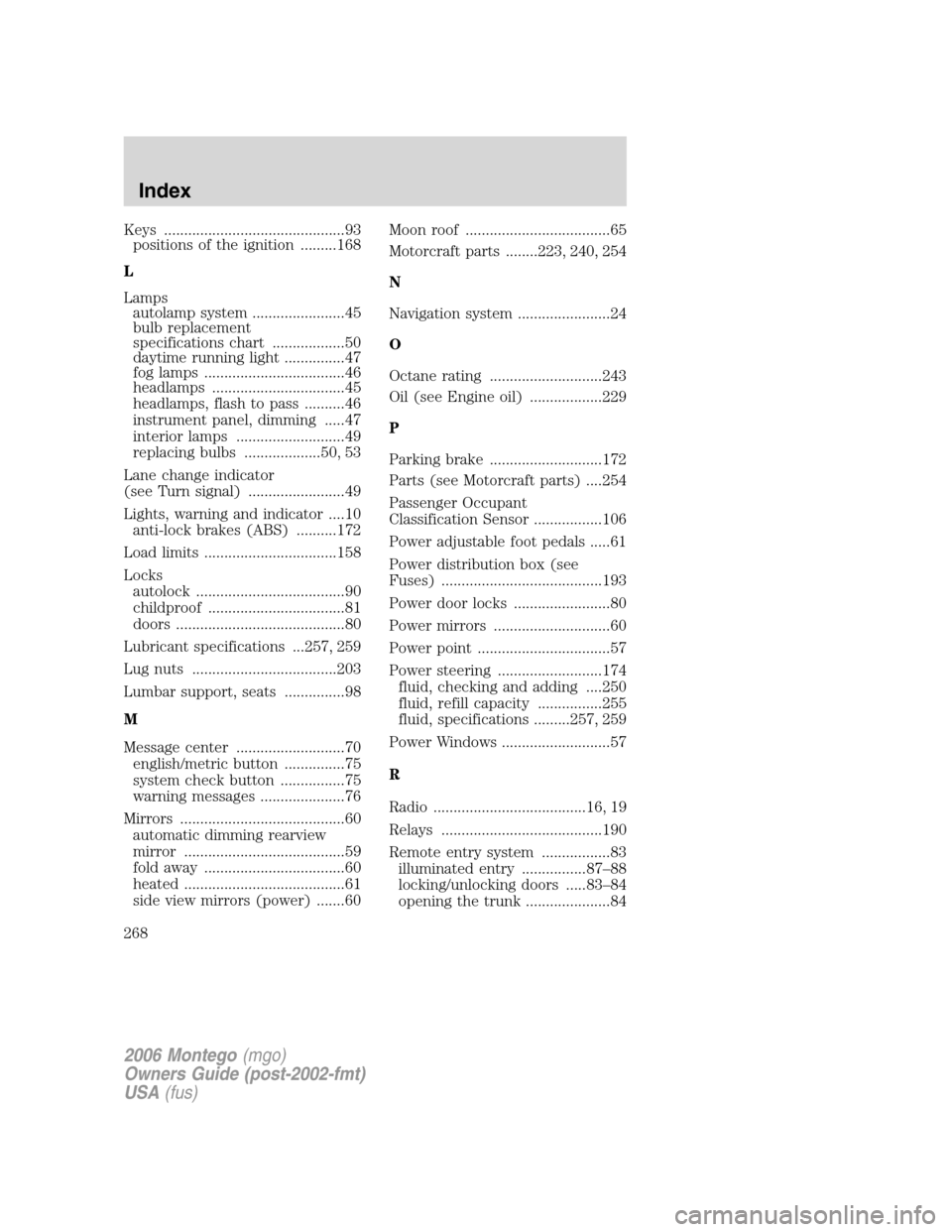
Keys .............................................93
positions of the ignition .........168
L
Lamps
autolamp system .......................45
bulb replacement
specifications chart ..................50
daytime running light ...............47
fog lamps ...................................46
headlamps .................................45
headlamps, flash to pass ..........46
instrument panel, dimming .....47
interior lamps ...........................49
replacing bulbs ...................50, 53
Lane change indicator
(see Turn signal) ........................49
Lights, warning and indicator ....10
anti-lock brakes (ABS) ..........172
Load limits .................................158
Locks
autolock .....................................90
childproof ..................................81
doors ..........................................80
Lubricant specifications ...257, 259
Lug nuts ....................................203
Lumbar support, seats ...............98
M
Message center ...........................70
english/metric button ...............75
system check button ................75
warning messages .....................76
Mirrors .........................................60
automatic dimming rearview
mirror ........................................59
fold away ...................................60
heated ........................................61
side view mirrors (power) .......60Moon roof ....................................65
Motorcraft parts ........223, 240, 254
N
Navigation system .......................24
O
Octane rating ............................243
Oil (see Engine oil) ..................229
P
Parking brake ............................172
Parts (see Motorcraft parts) ....254
Passenger Occupant
Classification Sensor .................106
Power adjustable foot pedals .....61
Power distribution box (see
Fuses) ........................................193
Power door locks ........................80
Power mirrors .............................60
Power point .................................57
Power steering ..........................174
fluid, checking and adding ....250
fluid, refill capacity ................255
fluid, specifications .........257, 259
Power Windows ...........................57
R
Radio ......................................16, 19
Relays ........................................190
Remote entry system .................83
illuminated entry ................87–88
locking/unlocking doors .....83–84
opening the trunk .....................84
2006 Montego(mgo)
Owners Guide (post-2002-fmt)
USA(fus)
Index
268